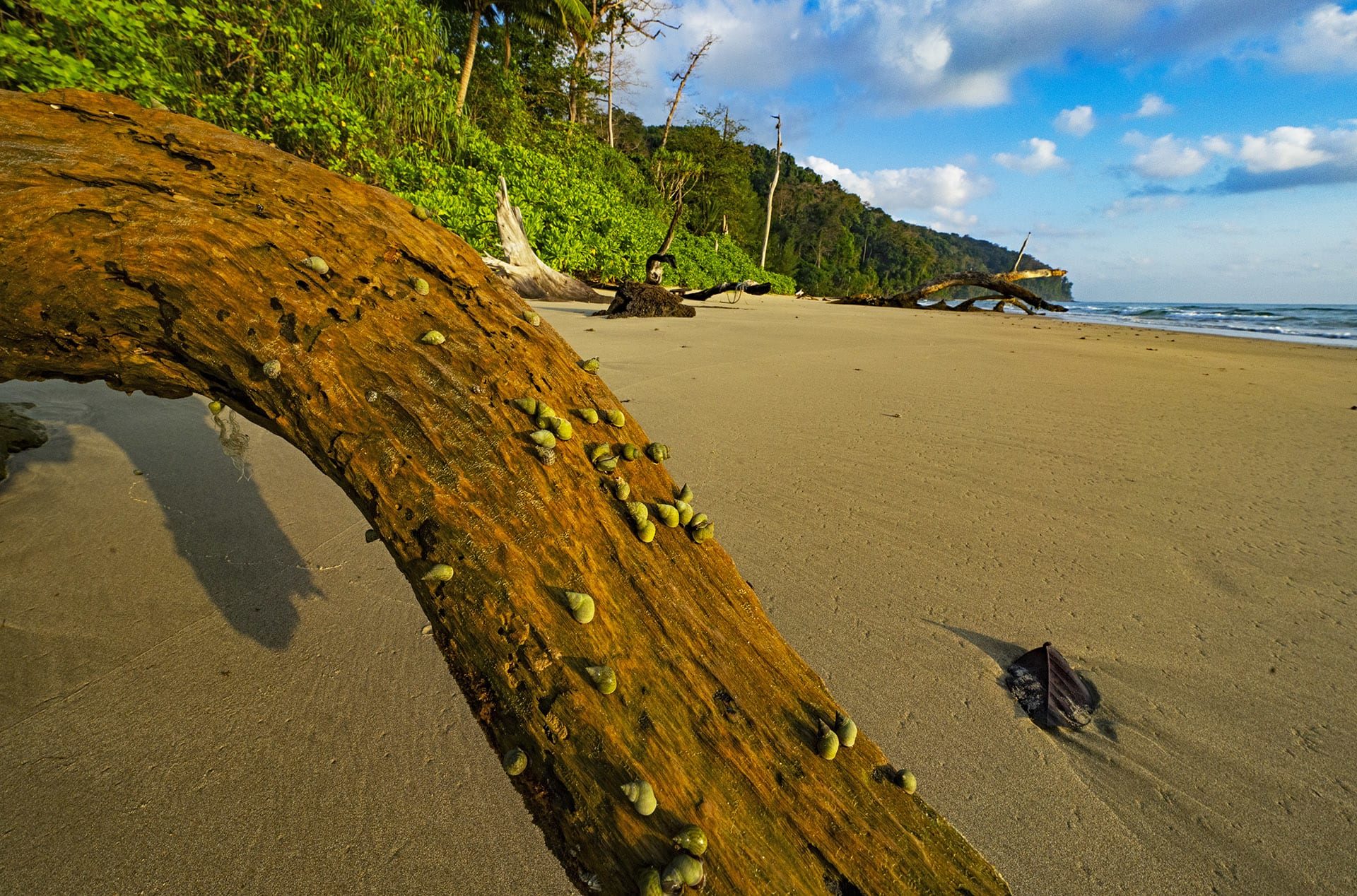The day I land in Great Nicobar, the last of 500-odd islands of the Andaman and Nicobar archipelago, I meet a man wearing a mask that reads “Bird Nerd”. “I can tell you where exactly to look for the Nicobar megapode,” says Shashank Dalvi, one of India’s leading ornithologists, “but I can’t guarantee you‘ll see it.” Dalvi moved here mid-pandemic with two assistants to study the island’s endemic birds. Wildlife photographer Dhritiman Mukherjee, a crew of filmmakers, and I, are here to document species unique to this archipelago. The Nicobar megapode (Megapodius nicobariensis), an endangered bird found only in the Nicobar group of islands, is on both our lists. “Look for a dead tree by the coast,” says Dalvi. “If a large mud mound circles its base, build your hide nearby. Settle down. It’ll be a while.”
At first glance, the Nicobar megapode looks like an ungainly, stocky brown chicken with large feet. Megapode literally means “big foot”. This ground-dwelling bird nests in a unique way. Instead of incubating its eggs with body heat, it builds a mound of sand, corals, and dry leaves. At the heart of it, in a burrow lined with leaves, it lays salmon-pink eggs. As the vegetation rots, the nest heats up like compost, and incubates the eggs. Built on top of one another over the years, old mounds can tower over six feet high and wide as a tennis court.

Galathea Bay, on the southern tip of the Great Nicobar Island is an ideal habitat for the megapode, with a long silver beach guarded by mangroves and littoral forests, and a lush rainforest that looks over the shore. Cover Photo: The Nicobar megapode, also known as the Nicobar scrubfowl, is a ground-dwelling bird that forages, builds nests, and spends most of its life on the forest floor.
One of the megapode’s abodes is Galathea Bay, at the southernmost tip of Great Nicobar Island. Here it builds mounds within 100 metres of the shore. We pitch our tents under the starspangled skies and settle down. Next morning, just before dawn, the megapodes sing — low-pitched wails reaching a crescendo and end with a metallic clatter. Jugloo and Prem, who work with the forest department, rush us in the direction of the song. We push through mangrove thickets to spot a dead tree circled by a mound. It looks like a shrine studded with twigs, seashells, even colourful rubber slippers brought in by the tide.
It is time to build a hide. Jugloo picks dead logs and ties them with jungle vines to create scaffolding. Coconut palm fronds make walls with natural gaps for camera lenses. Four of us squeeze in —elbows and knees sticking into each other. Four eventless hours pass. A monitor lizard known to feast on megapode eggs surveys the burrow. But no megapode.
Our first attempt is a taste of what the next three weeks will be like — lots of waiting, sweating, and nothing. Jugloo and Prem, locals to the island, reassure us. They know the megapode. As children, they hunted and devoured the “jungli murgi”. But in the 90s, the late conservation biologist Ravi Sankaran and his student K Sivakumar employed their skills to track the endangered bird. Over six years, Jugloo accompanied Sankaran across 16 islands, covering over 600 km mostly on foot. “Almost everything we know about the megapode comes from their work,” says Dalvi.
The Nicobar megapode is also called the “thermometer” bird since its large feet have sensors to test the temperature of the nests it builds on the forest floor. In the series of images above the megapode is seen surveying and digging its mound. This is often done to check on the eggs and maintain the right temperature for incubation.
“The bird follows a timetable and is often found in pairs,” says Prem. At noon they wander in a forest away from the mound. We see a fleeting flash of red from a distance. In the dark, the birds are brave, says Jugloo. Couples fly to tree branches and call to demarcate territory. We follow their duets, torches in hand, but in vain. The next morning, we settle in yet another hide opposite yet another mound.
The mound is the core of the megapode universe. Several pairs use the same mound, and form overlapping territories around it. “Think of a mound at the centre and a circle for every megapode territory that intersects at it,” says Dalvi sketching a rough diagram for us. It looks like an intersecting mandala with the mound for a heart. During the breeding season (February to May), the site turns into an arena. Fights erupt, solitary males chase females to win them over, pairs battle to lay claim to the mound. The winners get to spend most of their time there — picking the right spot, digging the nest. But once the female lays eggs, hierarchies shift, and another pair dominates.
After the eggs are laid, megapode pairs regularly visit their burrows to check on them. Their feet have sensors like thermometers. They scrape sand, add vegetation, to keep the temperature at about 33 degrees Celsius, perfect for incubation. When the eggs hatch, the chicks emerge in the most mature condition of any bird. They can run, fly, and even hunt on the same day!
We are here for the action, but we miss the megapode by a sliver every time. After six unsuccessful attempts, we move. Prem guides us through the Galathea River, over a mountain, through a canal, to camp at the other end of the bay. At 5 am the megapode calls suspiciously close to our tents. Barely awake, Mukherjee grabs his camera and darts into the forest barefoot. Minutes later, he is back, laughing. The country’s most pristine forests surround us, and he has a picture of the megapode running across the camp’s dry toilet.
The megapode wasn’t rare when the British used these isolated islands to imprison “criminals”, says Dalvi. The islands’ staggering biodiversity attracted zoologists like C Boden Kloss and WL Abbott in 1873 who spotted the megapode on almost all Nicobar islands. They saw it frequently enough to collect specimens and make curry.
So, how did a common bird fall in numbers on isolated islands with almost no predators? “Every story on the islands is shaped by the tsunami,” says Dalvi. In 2004, the tsunami slammed the archipelago, splitting and submerging entire islands. The megapode’s nests were battered. Megapode Island and Wildlife Sanctuary was swallowed entirely. The bird was declared locally extinct on Trax Island. In the 90s, researchers had counted at least 35 active mounds along Galathea Bay, where we are. Most were washed away. In a single moment, their population plummeted by about 70 per cent. Along the coasts, the saline waters killed trees, leaving behind dead stumps. On one survey, Sivakumar noticed that the megapode had started repurposing the ghost-like stumps into a nest. “Perhaps the dead tree provides a scaffolding for the mound. Plus, it is ready material for the compost,” says Dr Asad Rahmani, ornithologist and former director of BNHS.
Megapodes, like the islands, have been ignored, isolated and need urgent conservation attention. In 2011, the Indian Navy proposed a missile-testing range on Tillangchong, a narrow 17-sq-km island that hosts one of the largest megapode populations. The Navy had sought permission to use the ecologically sensitive forest land to erect a temporary structure for testing the accuracy of submarine-fired missiles. A panel of experts, led by Dr Rahmani, raised objections, and the plan was put on hold. But in January 2021, the government denotified several protected areas along the archipelago, including the Galathea Bay Wildlife Sanctuary and submerged Megapode Island. This is part of a larger plan to build transhipments ports and tourism hubs on the islands. The conservation of this habitat and endangered bird remains low on priority. For us, documenting its presence and habits is even more important in the face of looming “developments”.
It’s been three weeks, we’ve built eight hides and hopped three coasts, and all we have are fleeting glimpses of the megapode. On our last day, at 2.30 am, we take a motorboat to Navidera on the other end of the Great Nicobar Island. The sun peeks above the horizon as we step on shore. In a forest by the beach, we spot a dead tree and mound. We settle into a hide around 5 am — taking turns napping. Finally, at 4.30 pm, we hear the familiar clattering song. Through the gaps in the palm fronds, I see a blood-red head, a brown torso, and the famous thick foot approach a burrow. A calculated swipe here and there, and the pair saunters away. For a few minutes, there’s deafening silence. Then the hide erupts with squeals of joy. The seemingly ordinary “jungli murgi” has won us over.

